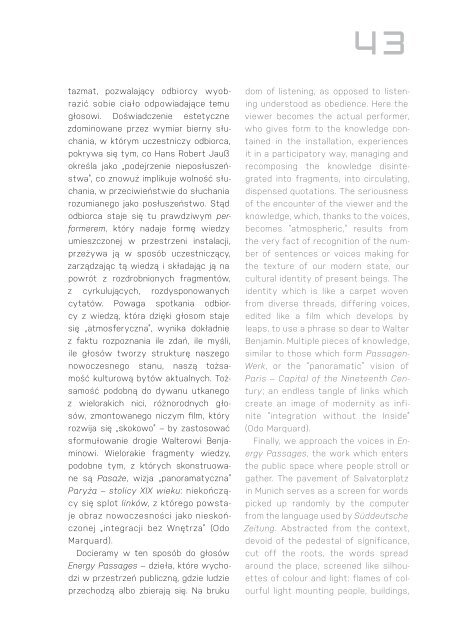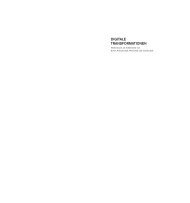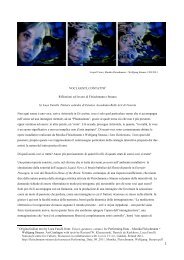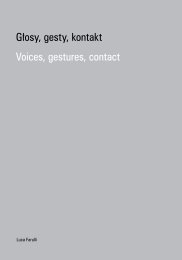Performing Data | Monika Fleischmann + Wolfgang Strauss
Performing Data is a review of Monika Fleischmann´s and Wolfgang Strauss´artistic body of work and a catalogue of their exhibition in Poland 2011. It presents works from Virtual Reality (Home of the Brain) up to Mixed Reality (Murmuring Fields) from Fluid Interface (Liquid Views) up to Floating Interface (Medienfluss) and texts by Ryszard W. Kluszczynski, Derrick de Kerkhove, Luca Farulli. Monika Fleischmann and Wolfgang Strauss from the German Fraunhofer research institute show us an intersection of the body and immaterial digital data. Immersion in data flow causes productive moments of disturbance and suspension, and consequently – a feeling of real physical presence. Fleischmann, Monika; Strauss, Wolfgang: Performing Data | Performowanie danych. National Centre for Culture, Warszawa 2011 in collaboration with Laznia CCArt, Gdańsk, Poland 2011 ISBN 978-83-61587-55-2 (en/pl) http://artline-southbaltic.eu/de/event/performing-data/
Performing Data is a review of Monika Fleischmann´s and Wolfgang Strauss´artistic body of work and a catalogue of their exhibition in Poland 2011. It presents works from Virtual Reality (Home of the Brain) up to Mixed Reality (Murmuring Fields) from Fluid Interface (Liquid Views) up to Floating Interface (Medienfluss) and texts by Ryszard W. Kluszczynski, Derrick de Kerkhove, Luca Farulli.
Monika Fleischmann and Wolfgang Strauss from the German Fraunhofer research institute show us an intersection of the body and immaterial digital data. Immersion in data flow causes productive moments of disturbance and suspension, and consequently – a feeling of real physical presence.
Fleischmann, Monika; Strauss, Wolfgang: Performing Data | Performowanie danych. National Centre for Culture, Warszawa 2011 in collaboration with Laznia CCArt, Gdańsk, Poland 2011 ISBN 978-83-61587-55-2 (en/pl) http://artline-southbaltic.eu/de/event/performing-data/
You also want an ePaper? Increase the reach of your titles
YUMPU automatically turns print PDFs into web optimized ePapers that Google loves.
tazmat, pozwalający odbiorcy wyobrazić<br />
sobie ciało odpowiadające temu<br />
głosowi. Doświadczenie estetyczne<br />
zdominowane przez wymiar bierny słuchania,<br />
w którym uczestniczy odbiorca,<br />
pokrywa się tym, co Hans Robert Jauß<br />
określa jako „podejrzenie nieposłuszeństwa”,<br />
co znowuż implikuje wolność słuchania,<br />
w przeciwieństwie do słuchania<br />
rozumianego jako posłuszeństwo. Stąd<br />
odbiorca staje się tu prawdziwym performerem,<br />
który nadaje formę wiedzy<br />
umieszczonej w przestrzeni instalacji,<br />
przeżywa ją w sposób uczestniczący,<br />
zarządzając tą wiedzą i składając ją na<br />
powrót z rozdrobnionych fragmentów,<br />
z cyrkulujących, rozdysponowanych<br />
cytatów. Powaga spotkania odbiorcy<br />
z wiedzą, która dzięki głosom staje<br />
się „atmosferyczna”, wynika dokładnie<br />
z faktu rozpoznania ile zdań, ile myśli,<br />
ile głosów tworzy strukturę naszego<br />
nowoczesnego stanu, naszą tożsamość<br />
kulturową bytów aktualnych. Tożsamość<br />
podobną do dywanu utkanego<br />
z wielorakich nici, różnorodnych głosów,<br />
zmontowanego niczym film, który<br />
rozwija się „skokowo” – by zastosować<br />
sformułowanie drogie Walterowi Benjaminowi.<br />
Wielorakie fragmenty wiedzy,<br />
podobne tym, z których skonstruowane<br />
są Pasaże, wizja „panoramatyczna”<br />
Paryża – stolicy XIX wieku: niekończący<br />
się splot linków, z którego powstaje<br />
obraz nowoczesności jako nieskończonej<br />
„integracji bez Wnętrza” (Odo<br />
Marquard).<br />
Docieramy w ten sposób do głosów<br />
Energy Passages – dzieła, które wychodzi<br />
w przestrzeń publiczną, gdzie ludzie<br />
przechodzą albo zbierają się. Na bruku<br />
dom of listening, as opposed to listening<br />
understood as obedience. Here the<br />
viewer becomes the actual performer,<br />
who gives form to the knowledge contained<br />
in the installation, experiences<br />
it in a participatory way, managing and<br />
recomposing the knowledge disintegrated<br />
into fragments, into circulating,<br />
dispensed quotations. The seriousness<br />
of the encounter of the viewer and the<br />
knowledge, which, thanks to the voices,<br />
becomes “atmospheric,” results from<br />
the very fact of recognition of the number<br />
of sentences or voices making for<br />
the texture of our modern state, our<br />
cultural identity of present beings. The<br />
identity which is like a carpet woven<br />
from diverse threads, differing voices,<br />
edited like a film which develops by<br />
leaps, to use a phrase so dear to Walter<br />
Benjamin. Multiple pieces of knowledge,<br />
similar to those which form Passagen-<br />
Werk, or the “panoramatic” vision of<br />
Paris – Capital of the Nineteenth Century;<br />
an endless tangle of links which<br />
create an image of modernity as infinite<br />
“integration without the Inside”<br />
(Odo Marquard).<br />
Finally, we approach the voices in Energy<br />
Passages, the work which enters<br />
the public space where people stroll or<br />
gather. The pavement of Salvatorplatz<br />
in Munich serves as a screen for words<br />
picked up randomly by the computer<br />
from the language used by Süddeutsche<br />
Zeitung. Abstracted from the context,<br />
devoid of the pedestal of significance,<br />
cut off the roots, the words spread<br />
around the place, screened like silhouettes<br />
of colour and light: flames of colourful<br />
light mounting people, buildings,







